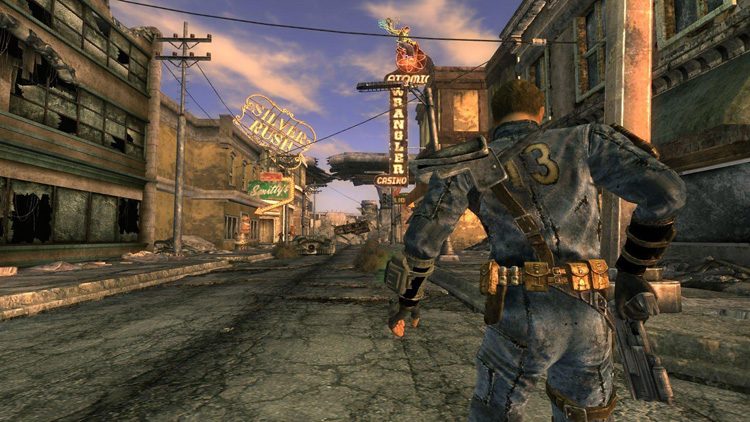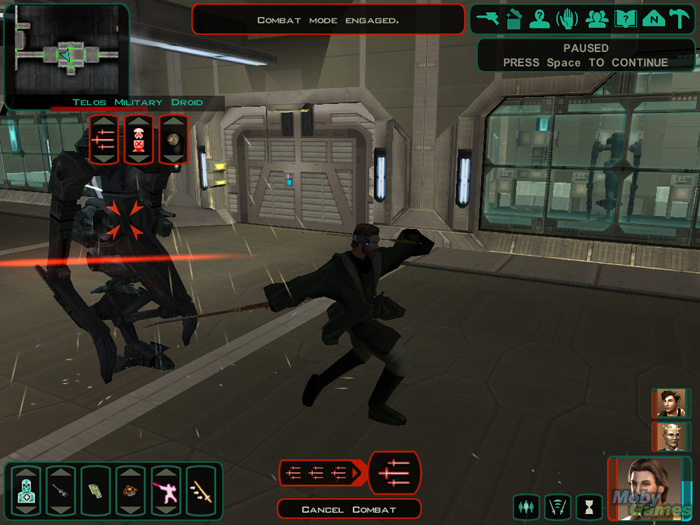The Presentation Layer
Like strategy games, CRPGs have complicated core mechanics, and the player needs access to a large amount of information. In addition to the game world, the player needs to see critical information about the health (and possibly mana status) of each member of the party. Spellcasting characters require a menu of the spells that they currently have available. Naturally, the type of machine you’re making the game for makes a big difference; CRPGs tend to have complicated user interfaces. A game for a mobile platform can take advantage of its touch screen, but doesn’t have much room on it to display a lot of information.
Interaction Model
Most single-player CRPGs today, and all multiplayer online ones, use an avatar-based interaction model. Players may also may have a familiar—a pet or companion who is under the player’s (sometimes indirect) control. These are seldom seen in any other genre. Older CRPGs normally used a party-based model, with the player controlling the activities of a small group of people who generally stay close together. Japanese RPGs, such as the Final Fantasy series, still use the party-based model.
Camera Model
The interaction model you choose to implement determines what camera model works for you. With an avatar-based model, either first- or third-person perspective is possible in 3D games, and many games offer both. The first-person perspective is useful for talking with other characters and moving fast through terrain; the third-person is more useful when the player wants to see her avatar fighting, casting spells, and so on. Fallout: New Vegas is a good example of a game that provides both (see Figure 7).

Figure 7 Fallout: New Vegas in the third-person perspective
If you are using a party-based model, you will probably want an aerial perspective so the player can see all the members of the party at once and position them as he wishes in combat. The aerial perspective also lets the player see more of the surrounding terrain, which helps characters explore and allows one character to scout a little way ahead for danger while still leaving the others visible on the screen. The isometric perspective was once the de facto standard for party-based play, but with the advent of 3D games, context-sensitive and free-roaming camera models are now commonplace.
User Interface
CRPGs usually permit a much greater range of possible actions for the player than games of other genres. Consequently, there is a corresponding increase in the complexity of the interface. Most PC titles offer an interface in which the player uses the mouse to click icons—though some still offer a keyboard-only interface—while console titles tend to use shooter-style interfaces using analog controllers.
Figure 8, from Knights of the Old Republic II: The Sith Lords, illustrates some of the complexities of CRPG interfaces. Figure 8 includes all the following elements: a mini-map (upper left); details about the current health and status of an enemy (left center); combat options during battle (lower left and center); party portraits (lower right); and buttons for switching to other gameplay modes such as character and inventory management (upper right).

Figure 8 Knights of the Old Republic II: The Sith Lords during a combat sequence
Visible Versus Hidden Mechanics
The first computerized games based on the Dungeons & Dragons system displayed actual die rolls on the screen so that the player could be confident that the games were following the real D&D rules. That was over 20 years ago, and nowadays the player does not need to be reminded that she is playing a computer game based on D&D rules. Of course, she should have access to the basic information such as attributes and skills, but exposing the inner mechanics of the game system in this way harms her immersion. One of the great benefits of computer gaming is that the player does not need to know how the software implements the rules.
Some players who are focused primarily on character advancement want to see all the numeric data, as opposed to the story-chasers who find that all the numeric data spoil the fantasy. Both types of player like CRPGs, but for different reasons, and you should not try to serve both groups. Players who like to see the mechanics of the game in operation need a very different user interface from those who prefer that the mechanics remain hidden.
Repetitive Tasks
Another legacy of the roots of CRPG in tabletop RPGs arises from the turn-based nature of the original games. Consider a character who has a 10 percent chance of picking a lock; the player may repeatedly click the Pick Lock button until he succeeds. This is dull and unnecessary, especially on a computer.
A better method is to display a progress bar. The speed with which the task progresses depends on the character’s skill in that area—that is, it progresses quickly for a character with a high skill level, slowly for one with a low skill level, or not at all if the task is beyond the character’s ability entirely.
This approach also allows the player to interrupt the task if it is taking too long. The progress bar could flash red if there is a chance of being interrupted, for example, if an enemy is within range of the player’s character and stands a chance of detecting the activity. Give the character a small amount of time—based on her dexterity and intelligence—to stop before being caught, or no chance of avoiding capture if the character’s combined dexterity and intelligence is too low. This approach aids immersion and heightens the tension and immediacy of the game.
